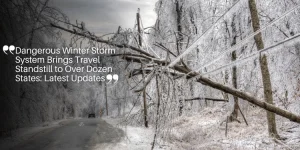The Hidden Cost of Housing: Exposing America’s Growing Credit Card Debt

Overview of the Train Derailment Incident in East Palestine, Ohio
Picture a serene town abruptly thrust into the national spotlight, not for celebratory reasons or technological advancements, but due to an incident with profound implications for its residents. This scenario unfolded in East Palestine, Ohio, when a train derailment rattled the community to its core.
On an otherwise ordinary day, East Palestine was rocked by a catastrophic train derailment, swiftly escalating from a local disruption to a national crisis. Freight cars, some laden with hazardous materials, careened off the tracks, triggering a fire that raged for days and prompting fears of air and water contamination. The immediate evacuation order underscored the severity of the incident, but as the flames subsided, deeper worries emerged about the community’s long-term financial well-being.
Immediate Impact on the Community’s Health and Safety
The aftermath of the derailment has left East Palestine residents grappling not only with physical cleanup but also ongoing health concerns and community division. Air and water safety were compromised, causing widespread anxiety about potential long-term health effects. Local businesses bore the brunt of the derailment’s impact, either through direct damage or reduced customer traffic due to health concerns, further destabilizing the local economy.
Many employees faced reduced hours or job losses, prompting reliance on credit cards for daily expenses. Health worries post-derailment translated into significant medical bills, especially for those without adequate insurance coverage. Charging these expenses to credit cards became a necessity for many.
Transition to the Broader Economic Implications
The economic reverberations of the East Palestine train derailment extend beyond immediate financial burdens. As the town coped with environmental and health concerns, residents faced immediate financial hurdles. Renters, typically with fewer resources and less stability than homeowners, found themselves particularly vulnerable. They often lack insurance coverage for such disasters and were uncertain about returning home or the habitability of their rental properties. This uncertainty led to unanticipated expenses, including temporary housing, increased travel costs, and replacing personal belongings.
The incident also highlighted a broader issue plaguing many Americans: the intersection of housing affordability and escalating credit card debt. High rents were already straining the finances of lower- and middle-income Americans, and disasters like the East Palestine derailment exacerbate these challenges.
Ultimately, the situation in East Palestine serves as a stark reminder of the financial instability lurking beneath the surface of many American communities, exacerbated by high rent and unforeseen crises. This context sets the stage for examining the financial vulnerability of renters, the factors contributing to debt accumulation, and strategies for navigating this complex landscape.
The Financial Toll on Renters
Vulnerability of Renters in Disaster Situations
The residents of East Palestine, Ohio, faced a significant upheaval in their lives following the catastrophic train derailment. For renters, the situation was particularly dire. Unlike homeowners, renters rarely have robust insurance policies that cover such unforeseen disasters. This vulnerability puts them in a precarious position, caught off guard by the sudden need for alternative housing and the financial burden that accompanies it.
Immediate Financial Hurdles Faced by Renters
Renters immediately faced a slew of financial hurdles post-derailment. With rental properties damaged or rendered uninhabitable, finding temporary housing became a priority. This urgency often led to paying inflated rates for hotels or short-term rentals. Additionally, increased travel costs surfaced as renters needed to commute from temporary accommodations to their workplaces or schools.
The derailment also brought about the cost of replacing personal belongings that were lost or damaged. For those without renters’ insurance, these out-of-pocket expenses quickly amassed, adding to an already stressful situation.
Lack of Insurance Coverage and Uncertainty About Property Habitability
A critical issue highlighting the financial strain on renters was the lack of insurance coverage. Without adequate insurance policies, many were left wondering how to afford the sudden expenses. Furthermore, renters faced uncertainty regarding the habitability of their properties. This ambiguity forced many into a prolonged state of limbo, unable to make long-term plans or commit financially to recovering from the incident.
The economic distress was not just immediate but extended as renters grappled with whether their homes would be safe to return to and whether landlords would make necessary repairs promptly.
By examining these financial challenges, we clearly see how disasters disproportionately impact renters. The experience of East Palestine serves as a stark reminder of the inherent vulnerabilities faced by those who rent, underscoring the urgent need for systemic changes and support mechanisms to aid them in such crises.
Transitioning from this nuanced exploration of the financial strain on renters, we turn our attention to the broader tapestry of economic hardships that can exacerbate debt accumulation in post-disaster scenarios.
Factors Driving Debt Accumulation
Loss of Income
The train derailment in East Palestine drastically disrupted the local economy, primarily hitting small businesses. Many local establishments either suffered direct damage or saw a significant drop in customer traffic due to health concerns. This led to reduced hours or job losses for employees, pushing them to rely more on credit cards for daily expenses.
Increased Medical Expenses
The health implications of the derailment became another significant financial burden. Many residents faced steep medical bills, especially those without adequate insurance coverage. With limited immediate funds, many turned to credit cards to cover these unforeseen medical expenses, adding to their mounting debt.
Relocation Costs and Unexpected Living Expenses
Health and safety concerns drove some residents to relocate temporarily, incurring costs like movers’ fees, security deposits, and rent payments at new locations. These unexpected expenses significantly strained their finances. Coupled with the high rents, these relocation costs created a perfect storm of debt accumulation. Residents were forced to rely on credit cards to manage these additional expenses, further exacerbating their debt levels.
The combination of losing income, facing increased medical bills, and bearing relocation costs created a challenging financial scenario for many in East Palestine.
While these factors compounded the immediate financial struggles, the broader community support and personal resilience formed a foundation for potential recovery.
The Intersection of High Rent and Credit Card Debt
How High Rents Contribute to Financial Instability
High rents have long been an issue for many Americans, but in times of unexpected disasters like the East Palestine train derailment, their impact becomes even more pronounced. Renters already allocating a significant portion of their income to housing find themselves without the financial flexibility to manage additional, unexpected expenses. The result? A slippery slope into financial instability.
Monthly rents siphon off potential savings that could otherwise cushion against emergencies. Instead of having a safety net, renters are left with little choice but to rely on alternative financial resources when disaster strikes. This financial tightrope is especially perilous in an event that disrupts jobs, health, and living conditions. Without any significant savings, the financial landscape turns grim very quickly.
The Role of Credit Cards in Covering Basic Expenses
When a crisis hits and funds are limited, credit cards become an all-too-tempting solution. With immediate needs piling up—ranging from groceries and medical supplies to temporary shelter—credit cards offer quick access to funds. However, this isn’t a cure but a costly band-aid. Interest rates on these cards can skyrocket, and if not managed prudently, the incurred debt can snowball rapidly.
Credit card debt often starts with essential purchases. Relocation costs, temporary lodging, and even daily necessities end up on credit cards when renters are squeezed by disaster-induced financial constraints. The ease of swiping a card provides short-term relief but leads to long-term debt accumulation.
The Perfect Storm: High Rent, Unexpected Costs, and Mounting Debt
Combining high rent with unforeseen costs like those from the East Palestine incident forms a ‘perfect storm’ that drives debt skyward. Residents affected by the derailment faced a cascade of financial burdens: job disruptions, relocation expenses, and increased medical costs. These factors force many to lean heavily on credit.
As debt rises, so does stress, making it difficult to think clearly and make sound financial decisions. The interplay of high rent, unexpected expenses, and accumulating debt traps renters in a vicious cycle. Those already vulnerable due to their economic situation find it near-impossible to climb out without substantial external support.
Understanding this dynamic is crucial for grasping the broader economic implications that stem from the East Palestine incident. The combination of high rent and rising debt under disruptive conditions offers key lessons on the fragility of financial stability among renters. These findings provide a valuable lens for exploring practical recovery strategies, which can act as lifelines for those facing similar crises.
Emotional Impact and Financial Decision-Making
Stress and Its Influence on Financial Choices
The chaos and uncertainty following the East Palestine train derailment left the community grappling with immense emotional strain. This stress significantly influenced their financial decisions, often leading to choices that exacerbated their precarious situations. When people are anxious and unsure about their future, they’re more likely to make hasty decisions, such as taking on high-interest debt or utilizing credit cards to cover daily expenses. The piling debts further escalated their financial woes, creating a vicious cycle of stress and poor financial judgment.
Community Division and Economic Recovery
The derailment not only fractured the physical safety of East Palestine but also sowed seeds of division within the community. Some residents wanted to move forward and restore normalcy, while others remained cautious about the lingering health risks. This divide made cohesive economic recovery difficult. Trust and collaboration, which are critical for communal economic resilience, were in short supply. As a result, the fragmented efforts to stabilize local businesses and individual finances faced significant hurdles.
The Cycle of Emotional Distress and Debt Accumulation
The ramifications of the train derailment extended beyond immediate financial loss, spiraling into a cycle of emotional distress and growing debt. The ongoing stress caused by financial instability led many to over-rely on credit cards, further sinking them into debt. This debt accumulation added to the emotional turmoil, creating a feedback loop where stress led to debt, and debt led to more stress. Without effective intervention and robust support systems, residents found it increasingly challenging to break free from this cycle.
As we delve deeper into solutions and support mechanisms, we’ll explore practical strategies for financial recovery and communal rejuvenation. The journey towards stability involves collective effort and strategic planning to mitigate the far-reaching economic impacts.
Strategies for Financial Recovery
Creating Comprehensive Budgets and Prioritizing Essential Spending
The first step toward financial recovery for East Palestine residents is creating a comprehensive budget. Start by listing all sources of income and categorizing expenses into essential and non-essential. Essential expenses include:
- Rent or mortgage payments
- Utility bills
- Groceries
- Medical expenses
- Transportation
By prioritizing essential spending, residents can ensure their basic needs are met while avoiding unnecessary costs. This approach helps maintain financial stability, especially in the aftermath of a disaster.
Negotiating with Creditors and Exploring Debt Consolidation Options
Negotiating with creditors can provide immediate financial relief. Many creditors are willing to work with individuals facing financial hardship to create more flexible repayment plans. Here are steps to take:
- Contact Creditors Early: The sooner you reach out, the more options you’ll likely have.
- Explain Your Situation: Be honest about your financial difficulties due to the train derailment.
- Request Lower Interest Rates or Payment Plans: Creditors may offer reduced interest rates or extended payment terms.
Exploring debt consolidation is another effective strategy. Consolidating multiple high-interest debts into a single low-interest loan can simplify payments and reduce overall interest costs. Options include:
- Credit card balance transfer offers
- Personal loans with lower interest rates
Seeking Financial Counseling and Community Support Programs
Financial counseling can provide personalized advice and strategies for managing debt. Certified financial counselors can help create realistic budgets, negotiate with creditors, and develop a long-term financial plan. Residents should seek out reputable organizations offering these services.
Additionally, community support programs can be invaluable. Local organizations and government aid programs offer various forms of assistance, including:
- Food banks
- Housing grants
- Unemployment benefits
Connecting with others in similar situations provides both emotional and practical support. Sharing experiences and resources can help residents feel less isolated and more empowered in their journey toward financial stability.
By implementing these strategies, residents can take concrete steps toward overcoming the financial challenges posed by the East Palestine train derailment.
Community Resources and Support Systems
Local Organizations and Government Aid Programs
After the East Palestine train derailment, local organizations and government aid programs have become essential lifelines for affected residents. These resources offer critical assistance to help families navigate through the financial chaos resulting from the incident.
- Food Banks and Shelters
Local food banks and shelters are among the first responders in times of crisis. They provide immediate necessities like food and temporary housing, ensuring that basic needs are met even when financial stability is in question. - Grants and Unemployment Benefits
Various government aid programs offer grants and unemployment benefits specifically tailored to disaster recovery. These financial aids help alleviate some of the immediate economic pressures by covering costs that residents would otherwise need to put on their credit cards.
The Importance of Connecting with Others in Similar Situations
Social support plays a vital role in recovery. Connecting with others who are going through similar struggles can offer both emotional and practical benefits.
- Shared Experiences
By sharing their experiences, affected residents can gain insights and strategies for navigating the labyrinth of financial recovery. This sharing can provide not just emotional solace but also practical tips on managing debt and finding additional resources. - Support Groups
Community-organized support groups create safe spaces to discuss financial challenges without judgment. These groups can offer collective wisdom on dealing with creditors, applying for aid, and other financial recovery steps.
Collective Support in the Recovery Process
There’s immense power in collective effort. When a community comes together, it can create a strong support network that accelerates recovery.
- Fundraisers and Donation Drives
Local fundraisers and donation drives can accumulate capital to help those who need it most. These initiatives also foster a sense of unity and purpose, reinforcing that no one has to face their financial struggles alone. - Community Counseling Programs
Community counseling programs provide professional advice on financial management, debt consolidation, and mental health. They are crucial for long-term stability since they help residents develop sustainable strategies for managing their finances post-disaster.
Utilizing these community resources and support systems can significantly bolster a resident’s financial recovery efforts, offering a pathway towards rebuilding not just homes, but lives.






